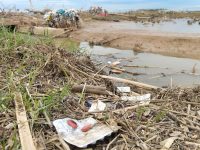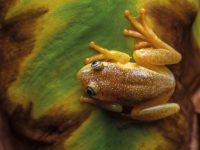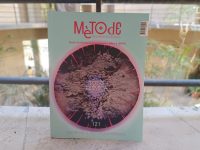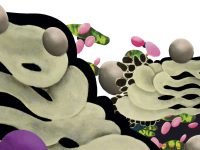I am driving in the middle of nowhere. I must have been going straight for ten minutes without meeting any other vehicles. Half an hour ago, a sign announced that the next town would be Bajo Caracoles, some 200 km away. For the four hours I have been driving since I landed in Calafate and rented a car, there is nothing but pure Patagonian steppe on either side: rocky ochre soil with round grass clumps about 30 cm high which, at this time of year (summer in the southern hemisphere) are grey, yellow, and the occasional dull green.
At first the scenery is breathtaking, like something out of a film. But it starts to get tiring. Besides, I cannot enjoy it because I have to watch out for unexpected potholes in the middle of this legendary Ruta 40.
Every few minutes, guanacos, animals of the camelid family that look like slightly more slender and less woolly llamas, can be seen along the roadside. Most of them are alive, but I have already spotted seven or eight carcasses hanging by their hind legs from the wires of the rudimentary fences that try to keep them off the road. They seem to be able to easily leap over them, but if one of them miscalculates and the wire catches it right between the beginning of its thighs and abdomen, it gets stuck there at the disposal of the condors that fly over the area.
«On the rocky road, I overtake a cyclist who must be cycling across Patagonia as a lifetime achievement. I do not get it»
My destination? A lodge called La Posta de los Toldos, where tomorrow I am meeting a technician from the Rewilding Argentina foundation, who will show me the scientific and conservation projects they are promoting in the middle of this desert. I am worried because I did not expect the road to be so bad, and I had been told not to arrive later than nine o’clock at night. There is no phone signal, no internet connection, no data, nothing at all.
Having no internet access may seem romantic, a liberation, even, but a while ago the asphalt suddenly disappeared for about 70 metres of gravel (which they call ripio here), the rear wheels of the car slipped, I hit the side fence and was left without a rear bumper (and wondering what I would have done if the car had not started).
Anyway, the four long hours of driving I still have to do remain the same. On the rocky road, I overtake a cyclist who must be cycling across Patagonia as a lifetime achievement. I do not get it. No matter how much I think about it, with that wind, dry climate, hard road, and monotonous landscape, it seems absurd (even more so when, two days later, I find him on my way back to Calafate, cycling in the same direction, only around 300 km further down the road).
With doubts as to whether my motivation is also absurd, I arrive at La Posta, a few lonely cottages at the end of a dirt track off the main road. In the morning I meet Franco Butti from Rewilding. He is a local from Perito Moreno (the town, not the glacier). His family are cattle ranchers, but he was always involved in preservation, speaking out against mining and warning that other models of development were needed, until he was hired by the foundation as a photographer and technician. He lives with a few other people in an isolated biological station in a canyon that we reach in his all-terrain vehicle and where every winter they go into lockdown due to snowfall. Their rewilding function involves restoring ecosystems and native species that have been degraded over the decades and promoting social and economic development based on ecotourism and conservation. How do they do it?
The model is interesting: thanks to abundant funding from donors, especially the Tompkins Conservation Foundation, they buy huge extensions of land, manage them according to their preservation criteria, develop them for public use and create opportunities for the local population, and finally return them to the state on the condition that they are declared natural parks. Tompkins Conservation, created by the former owners of The North Face, has already completed similar processes in Chile and northern Argentina, in Iberá National Park, where they have reintroduced jaguars, anteaters, and plants into a place that was a natural wonder just a few decades ago. It fell from grace, but is now again a booming natural park.
«Rewilding’s function involves restoring ecosystems and native species that have been degraded over the decades»
After a while explaining his projects to me, Franco opens his laptop and shows me several points on a map that reflect the signals received every three hours from the collar of one of the ten pumas they monitor. «That’s weird… Since yesterday, this one hasn’t moved much. It must have hunted something. Do you want to go and see if we can find him?» Franco says to me. «Well, of course!»
After a beautiful steppe drive in the all-terrain, we descend and walk across the hills where the puma might be. After an hour and a half I dare ask him whether it will be much longer. Franco makes a «who knows» gesture. He carries some kind of antenna connected to a walkie-talkie that picks up the puma’s collar when it is less than a kilometre away. Nothing to be heard yet. Every time Franco raises the antenna, he points to another hill and says «It might be back there». I think of the cyclist and the phrase «To each their own». But one of these times, he puts the walkie-talkie to my ear and I hear peep, peep, peep… The puma is close! We follow the signal, but it seems to be moving away from us, and so much time passes that I am already doubtful we will find it. Franco stops on the side of a small hill, looks down and says: «I think it must be here somewhere». It is all the same to me, so I take it as a break. But suddenly Franco points down and shouts without shouting: «Look!» Less than 50 metres away, I see a puma walking slowly in front of us, standing on the slope of the next hill. We see it perfectly, and it sees us. Franco knows it is a female puma that gave birth three months ago and interprets that, if she is not leaving, it must be because her cubs are close by. We stare at it for several minutes, take photos, and looking around we see something on the ground… It is the body of a guanaco.
We get closer, and the image, which in another context would have seemed rough to me, was completely natural: its belly was open, its ribs were broken from the first bites, and there was a very prominent mark on its neck. Franco explains to me that pumas do not chase their prey, but hide and jump onto their neck to bite it and squeeze until they suffocate. At that moment, I am already fascinated and I am aware that the unforgettable moment justifies the kilometres, the fatigue, and even the bumper bill. But then, a few minutes later, on our first steps on the way back, two orange cubs come running out from behind some bushes towards their mother.
It is wonderful, awe-inspiring. It is only a few minutes, but my mind will multiply them countless times as I remember them. I look at Franco with gratitude. Both for this moment and, most of all, for the effort and passion that Rewilding puts into returning wildlife to these areas. I feel that this trip has changed me. And the science and the adventure had only just begun….





